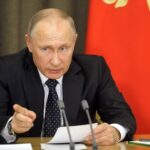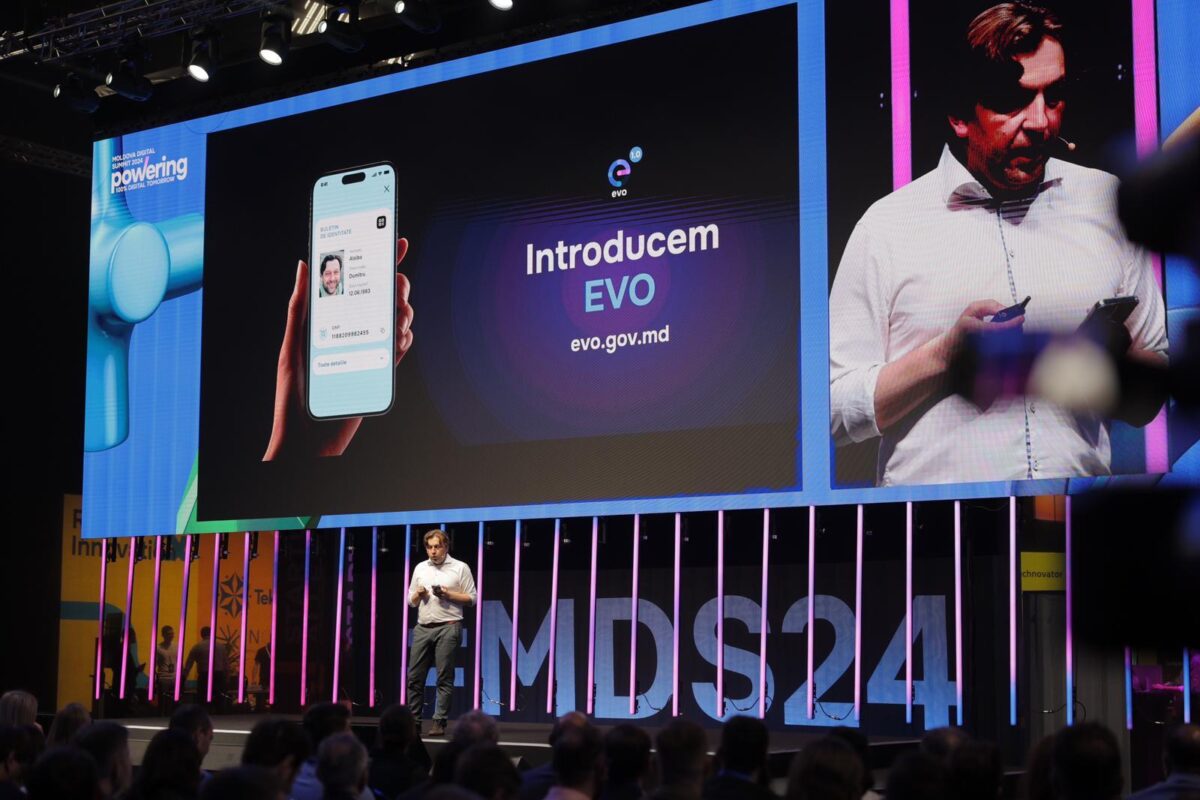A state that respects its citizens and provides them with services and information—not a state that sends its citizens on a bureaucratic paper chase every time they need to get something done.
That, says Dumitru Alaiba, Moldova’s deputy prime minister and minister of economic development and digitalisation, is one of the underlying concepts behind the country’s digital transformation, which was on full display last week at the Moldova Digital Summit—a showcase for Moldova’s progress so far, and a demonstration of its further potential.
“For years, our entrepreneurs had to travel outside of the country to attend an event such as this,” adds Alaiba, pictured above on stage at the summit. “Now we have an event that rivals anything in the region.”
Increasingly, Moldova has a digital society that can rival anything else in the region too. One of the highlights of the summit was the launch of EVO, an app designed to bring Moldova’s people—and businesses—closer to public services.
The app incorporates a number of digital documents—ID card, driver’s license, registration certificate—in a secure and simple way, and carries the same legal power as physical documents— it was Alaiba who pushed through the relevant legislation last year. To demonstrate, Alaiba pulls out his phone and shows me his ID card—stored digitally in the app.
Within a few years, EVO will make all public services available at the touch of a smartphone screen. The target date is 2030, but Alaiba believes that it will be reached much earlier.
For the business sector, the target could be met in just a couple of years. “This time last year 38 per cent of public services for companies were available online,” he says. “It’s now 60 per cent. By the end of this year it will be 75 per cent.”
Alaiba adds that in the first quarter of this year, of the 1.2 million business-government interactions that could be carried out digitally, one million were. He admits that take-up among the general public is slower, but that “around a third” of interactions are now digital.
Redefining Moldova
As well as making the lives of citizens less bureaucratic and facilitating the ease of business, digital societies are also more transparent—and less corrupt.
“Our score on Transparency International’s Corruption Perceptions Index has never been better,” says Alaiba, “but there is still a long way to go and a lot of work to do. We see digitalisation as a very efficient measure to prevent corruption. It’s about building trust and transforming the way the government is seen by people and entrepreneurs.”
Moldova’s digital push also represents a significant leap that enhances the nation’s global image and attractiveness as a modern, dynamic destination for foreign investment. As the world increasingly embraces digital technologies, Moldova’s commitment to developing robust, seamless digital public services is a strategic move to streamline government operations, enhance transparency, and improve the overall efficiency of public administration.
This transition not only bolsters the country’s administrative capabilities but also signals to the international community that Moldova is dedicated to fostering an innovative and business-friendly environment.
“We see economic development, of which digitalisation is a key driver, as a huge opportunity to redefine what Moldova means and how it is seen from outside. It’s a country that is changing fast, that is developing, that is modernising,” says Alaiba.
Indeed, Alaiba believes that digitalisation is a huge economic enabler—and is keen to ensure that progress is not limited to the country’s booming IT sector. “We see digitalisation as an opportunity to leap forwards, to offer the economy a productivity and efficiency boost in each and every sector,” he says.
The IT sector
Nevertheless, it is currently Moldova’s IT sector that is the country’s flagship industry—an increasingly important part of the country’s brand. “We are a regional leader in IT and I am proud of that, says Alaiba.”
The sector has been bolstered by the Moldova Information Technology Park (MITP), Europe’s first e-park whose residents benefit from a flat tax rate of seven per cent on turnover. Now accounting for around 80 per cent of the Moldovan IT sector and some five per cent of Moldovan exports, it’s an initiative whose success recently saw its lifespan extended until at least 2035.
MITP’s success means that in 2022 Moldova had the highest ICT services growth rates among neighbouring countries and regional competitors (Ukraine, Belarus, Romania, Estonia, Latvia and Lithuania). Good infrastructure has helped—the average internet speed in Moldova is higher than in some more developed countries (such as Germany, Switzerland or Estonia).
Moldova’s digital transformation reached a milestone in September 2023 with the official endorsement of the country’s Digital Transformation Strategy for 2023-2030. It sets out an ambitious goal: to become an innovative, all-encompassing digital society with modern infrastructure, digitally literate citizens, a pro-digital administration, a thriving digital business community, and a collaborative environment fostering innovation and sustainable human development.
“[The strategy] prioritises the interests of our citizens, promoting innovation and entrepreneurship, and attracting foreign investment,” says Alaiba.
Then there’s the Digital Europe Programme, which Moldova joined in February. Moldova’s admission to the programme will permit businesses, town halls, NGOs and central authorities to access EU funding for digitalisation projects with a budget of 7.5 billion euros for 2021–2027. Moldova will be able to benefit from financial support and expertise to improve its digital infrastructure and promote innovation and digital inclusion.
“It was a document I was very happy to sign,” says Alaiba. “It’s a huge opportunity for our public sector, our SMEs, and our entrepreneurs.”
‘We are building a business-enabling state’
Digitalisation is crucial for Moldova as it seeks to compete on the European stage, offering a secure digital infrastructure that can attract international investors. By simplifying bureaucratic processes, reducing corruption, and ensuring greater accessibility to government services, digital public services can significantly enhance the ease of doing business in Moldova.
This, in turn, can attract foreign businesses looking for a stable and efficient market to invest in, contributing to economic growth and development. As Alaiba puts it, “we’re not just building a digital state, we are building a business-enabling state”.
“This really is the moment for businesses to move into Moldova and to really start growing together with the country,” he adds. “The cost of entry is still relatively low. But we’re looking at a period of accelerated economic growth—I want high single figure growth—so it won’t remain low cost forever.”
“At every business forum with every investor, the message I am putting across is this: moving into Moldova right now, you will triple your investment in the next decade. But it must be now, because in two years’ time, it might be too late.”







